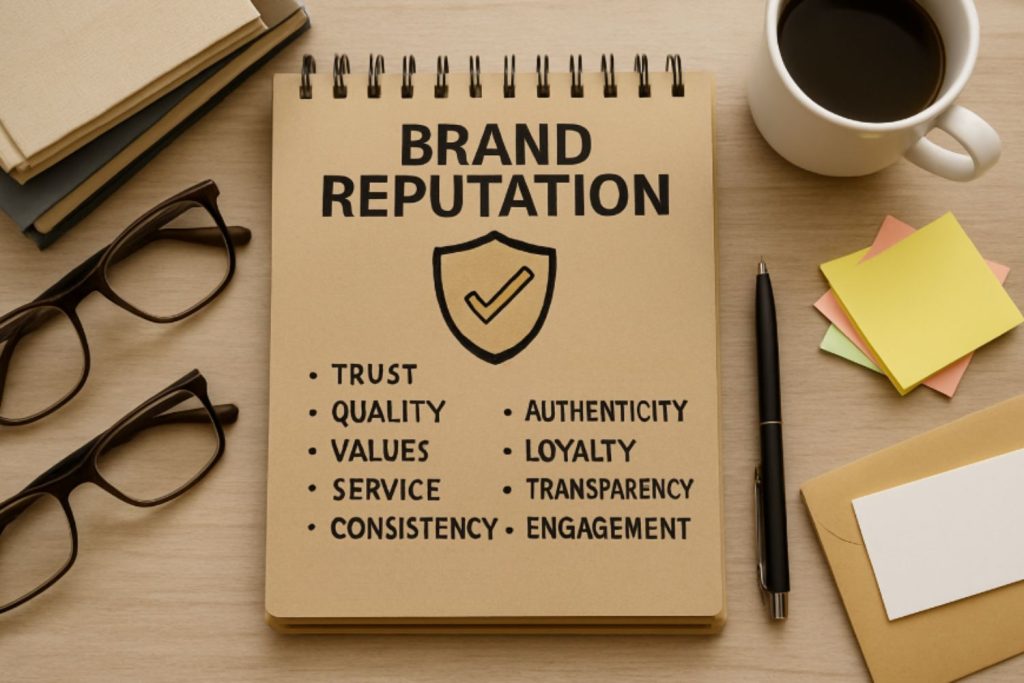
Think about the last time you recommended a company to a friend. Maybe it was a local café where the staff remembered your order, or an online brand that refunded a faulty product without a single hassle. You didn’t share that story because of a flashy ad, you shared it because of how the brand made you feel.
That’s the essence of brand reputation. It isn’t built on logos or taglines alone; it’s built on the consistent experiences people have with your company over time. A strong brand reputation earns trust, fuels customer loyalty, and can even protect your business during tough times. A weak one? It can undo years of marketing in a single bad review.
The journey to build brand reputation might seem complex, but it can be broken down into a clear, strategic framework. This guide will walk you through that process, offering a practical and structured approach to cultivating a brand reputation that not only attracts customers but turns them into lifelong advocates.
What Is Brand Reputation & Why Is It Important
Brand reputation is the way people perceive your company based on their experiences, what they’ve heard from others, and how you show up in the market. It’s not something you control directly, it’s something you earn over time. Every customer interaction, review, and touchpoint contributes to the story people tell about your brand.
A good reputation is one of the most valuable assets a business can have. It builds trust, attracts loyal customers, and helps you stand out in crowded markets. A poor reputation, on the other hand, can spread quickly and undo years of effort.
How Brand Reputation Impacts Business Success?
A strong reputation is far more than a feel-good metric; it’s a fundamental driver of commercial success. It operates quietly in the background, influencing nearly every aspect of your business.
- Customer Trust & Loyalty: When people perceive your brand as reliable and ethical, they trust you. This trust is the foundation of loyalty. A loyal customer doesn’t just return; they do so with a sense of certainty, eliminating the need for you to compete on price alone for their business every single time.
- Word-of-Mouth and Referrals: When people have great experiences, they share them. Whether they leave a positive review, post on social media, or recommend you to a friend, word-of-mouth powered by a good reputation can be more persuasive than any ad campaign.
- Revenue, Pricing Power & Margins: A positive reputation directly translates to financial strength. Customers are often willing to pay a premium for products or services from a company they believe in. This pricing power protects your profit margins and creates a more resilient business, capable of weathering market fluctuations and competitive pressures.
💡If you are curious to know how visibility shapes perception, explore our guide on the impact of social media on brand awareness.
Key Elements That Shape Reputation
Your reputation isn’t formed by any single event. It’s shaped continuously by a combination of factors, each playing a critical role.
- Values, Mission & Identity: What your company stands for matters deeply to modern consumers. A clear mission and a set of authentic values act as a compass for your business decisions. When your actions consistently align with your stated beliefs, you build credibility and attract an audience that shares your principles.
- Quality & Consistency of Product/Service: This is the non-negotiable foundation. Your product must deliver on its promise. Consistency builds predictability, and predictability builds trust. Every reliable interaction reinforces the perception that your company is competent and dependable.
- Customer Experience & Support: From the first website visit to post-purchase support, every touchpoint is an opportunity to build or erode your reputation. Exceptional service, especially when resolving issues, can often create more customer loyalty than a flawless initial transaction.
- Transparency & Authenticity: In an era of information, attempts to hide mistakes or mislead are often uncovered. Being honest about challenges, clear in your communication, and genuine in your interactions shows respect for your audience. This builds a deeper, more human connection that people remember.

The 9 Proven Strategies to Build Brand Reputation
Reputation doesn’t happen by accident, it’s the result of deliberate actions taken consistently over time. The strongest brands aren’t just known for what they sell, but for how they operate, how they treat customers, and how they respond when things go wrong.
Through years of observing what works (and what doesn’t), nine strategies consistently stand out. These are practical steps any business, whether a startup or an established brand, can use to strengthen trust, earn loyalty, and stand apart from the competition.
Strategy 1: Define & Communicate Clear Brand Values
Your brand values are your guiding principles, the fundamental beliefs that dictate your behavior and decision-making. Before you can build a reputation, you must know what you stand for. Articulate a clear mission and set of values that go beyond profit. Then, live by them.
Weave these values into your storytelling, your hiring process, and your company culture. When your actions consistently reflect your stated values, you attract like-minded customers and employees, building a foundation of authenticity that people can believe in.
Practical ways to apply this:
- Write down 3–5 non-negotiable values (e.g., sustainability, transparency, innovation).
- Share stories that show how your team lives those values in practice.
- Make sure your values aren’t just marketing slogans, they should influence hiring, partnerships, and even product design.
When customers see a brand consistently act in line with its values, it doesn’t just build awareness, it builds respect. And respect is the foundation of long-term reputation.
If brand awareness is still a gap, here’s how to increase brand awareness with practical steps you can start today.
Strategy 2: Deliver Exceptional Customer Service & Support
If there’s one thing that can strengthen or destroy brand reputation almost instantly, it’s customer service. People might forgive a delayed shipment or a small mistake, but they rarely forget how a brand treated them when they needed help.
Exceptional service goes beyond solving problems, it shows customers that they’re valued. Quick responses, clear communication, and a willingness to make things right can turn a frustrated buyer into a loyal advocate. On the flip side, slow replies or dismissive support can spark negative reviews that spread fast.
Practical ways to apply this:
- Offer multiple support channels (chat, email, social media) and ensure someone is actually listening.
- Train your team to solve issues with empathy, not just scripts.
- Follow up after a problem is resolved to show you care about the outcome.
When customers feel supported, they don’t just stick around, they share their positive experiences with others. That word-of-mouth is one of the most powerful reputation builders you can get.
Strategy 3: Maintain Consistency Across All Channels
A brand with a strong reputation feels the same no matter where people encounter it. Whether it’s a tweet, a product package, a website visit, or an in-store experience, customers should recognize your voice, your style, and your standards.
Inconsistency confuses people and weakens trust. If your ads are playful but your customer emails sound robotic, or if your website promises one thing but your product delivers another, it sends mixed signals.
Consistency, on the other hand, builds familiarity, and familiarity breeds trust. A good reputation can be more persuasive than any ad campaign, especially as the impact of influencer marketing on consumer behaviour continues to grow.
Practical ways to apply this:
- Visual Branding (Logos, Design, Style): Maintain a uniform visual identity with consistent use of your logo, color palette, typography, and imagery. This visual repetition makes your brand instantly recognizable and conveys professionalism.
- Messaging & Tone of Voice: Whether your tone is formal, friendly, or witty, it should remain consistent across all written and verbal communication. A recognizable voice makes your brand feel more human and relatable.
When people know what to expect from you, they feel more confident choosing you again and again. That reliability is a cornerstone of lasting brand reputation.
Strategy 4: Be Transparent & Honest
Reputation is built on trust, and trust only grows when a brand is open and honest. Customers don’t expect perfection, but they do expect honesty when something goes wrong. Trying to cover up mistakes, hiding important details, or overpromising quickly damages credibility.
Transparency shows people that your brand values honesty over spin. Whether it’s being upfront about pricing, admitting when a product has an issue, or clearly explaining policies, openness makes customers feel respected. And when they feel respected, they’re more likely to forgive small missteps and stay loyal.
Practical ways to apply this:
- Share updates publicly if there are delays or product issues, instead of waiting for customers to discover them.
- Avoid fine print that confuses, write terms and policies in plain language.
- If your brand takes a stand on an issue, back it up with real actions, not just statements.
The truth is simple: transparency might feel risky in the short term, but in the long run, it protects and strengthens your brand reputation far more than silence ever could.
Strategy 5: Collect & Act on Customer Feedback
A brand’s reputation is shaped not only by what you say about yourself, but also by what customers say about you. That’s why feedback is such a powerful tool, it shows you how people actually experience your brand and where you can improve.
Too many companies ask for feedback but never act on it. That leaves customers feeling ignored, which can hurt trust. The brands that stand out are the ones that listen carefully and make visible changes based on what they hear.
Practical ways to apply this:
- Use surveys, reviews, and social listening tools to gather ongoing feedback.
- Thank customers for their input, even when it’s negative.
- Close the loop: let people know when you’ve made improvements based on their suggestions.
When customers see their voices shaping your products, services, or policies, they don’t just feel heard, they feel valued. And that feeling is what turns everyday buyers into loyal advocates who boost your reputation over time.

Strategy 6: Use Thought Leadership & Content Marketing
Establish your brand as a knowledgeable and trustworthy authority in your field. Share your expertise not just to sell but to educate and help your audience. Create high-quality content, such as blogs, whitepapers, webinars, and videos, that addresses their challenges and answers their questions. By providing genuine value without an immediate expectation of return, you build goodwill, strengthen your brand’s credibility, and become a respected resource.
When people consistently learn something useful from your brand, they begin to see you as a trusted authority in your field. Over time, that trust translates into stronger loyalty and a positive reputation that competitors can’t easily copy.
Practical ways to apply this:
- Publish blog posts, guides, or videos that answer common questions in your industry.
- Share data-backed insights, case studies, or original research.
- Host webinars, podcasts, or events where your team can showcase expertise.
- Encourage leaders or team members to share perspectives on LinkedIn and other platforms.
Reputation thrives when your brand is known as more than a product or service provider. By consistently delivering value through content, you position yourself as a go-to resource, and that’s a reputation that lasts.
Strategy 7: Manage & Respond to Negative Feedback or Crises
Even the strongest brands face criticism or unexpected challenges. What sets reputable companies apart is how they handle those moments. Ignoring complaints or going silent during a crisis usually makes things worse. Addressing issues quickly, honestly, and with empathy shows customers that you take responsibility and care about making things right.
A negative review or social media comment can actually become an opportunity. Responding respectfully and offering a solution doesn’t just satisfy the unhappy customer, it also shows everyone watching that your brand values accountability.
Practical ways to apply this:
- Monitor reviews, social mentions, and feedback channels regularly so you can respond quickly.
- Acknowledge mistakes openly and outline the steps you’re taking to fix them.
- Train your team on crisis communication: stay calm, stay human, and avoid defensive language.
- Follow up after a resolution to ensure the customer is satisfied.
Handled well, even tough situations can strengthen trust and prove your brand’s commitment to its values.
Strategy 8: Leverage Partnerships, Influencers & Advocates
Reputation doesn’t grow in isolation. The people and brands you associate with can elevate how others see you. Strategic partnerships, influencer collaborations, and loyal advocates extend your reach while reinforcing your credibility.
When an influencer or respected partner endorses your brand, their trust transfers to you. Customers who already value their opinion are more likely to give your brand a chance. The same goes for advocates, loyal customers who recommend you without being asked often create the most authentic form of marketing.
Practical ways to apply this:
- Partner with influencers who genuinely align with your values and audience. Use an influencer discovery tool to filter by audience fit, engagement quality, and brand alignment.
- Collaborate with complementary brands on campaigns, bundles, or events. Streamline collaboration with an influencer outreach tool so invites, briefs, and follow-ups are consistent and on-brand.
- Create referral or loyalty programs that reward your strongest advocates.
- Showcase testimonials, case studies, and user-generated content as proof of trust.
When people see others who respect standing beside your brand, it strengthens the reputation you’re working to build.
Strategy 9: Monitor, Measure & Adapt Reputation Over Time
Reputation isn’t something you build once and then forget about, it’s dynamic. Customer expectations change, new competitors enter the market, and social platforms amplify voices faster than ever. That’s why monitoring and adapting your reputation strategy is just as important as building it in the first place.
Brands that consistently track how they’re perceived can spot risks early and identify new opportunities. Those who don’t often get blindsided by issues that could have been prevented with a little listening.
Practical ways to apply this:
- Use tools to track reviews, brand mentions, and social sentiment.
- Set reputation KPIs like Net Promoter Score (NPS), average review rating, or share of voice.
- Regularly analyze customer feedback to spot trends and recurring issues.
- Update your brand strategy when market conditions or audience expectations shift.
By treating reputation as an ongoing process, not a one-time project, you’ll stay aligned with your customers and keep the trust you’ve worked hard to earn.

Online vs Offline Reputation: What to Prioritize?
A strong brand reputation doesn’t exist only on the internet or just in face-to-face interactions, it’s built across both worlds. The challenge for most businesses is deciding where to put their focus. The truth is, online and offline reputation feed into each other. A poor customer service experience in-store can end up as a one-star review online, while a strong digital presence can encourage people to show up in person. Knowing how to balance the two helps ensure consistency everywhere your brand shows up.
Online Reputation Tactics
Your online presence is often the first, and sometimes only, point of contact for potential customers. It’s your digital handshake and your public ledger, making its management non-negotiable.
- Reviews & ratings: For many consumers, reviews are the new word-of-mouth. Proactively manage your profiles on key platforms like Google Business Profile, industry-specific sites, and social media. Encourage satisfied customers to share their experiences. Respond to all reviews, thankful for the positive ones and constructive and professional in addressing the negative. This shows you are attentive and value all customer feedback.
- Social media presence & engagement: Social media is not just a broadcasting channel; it’s a conversation. Use it to showcase your brand’s personality, values, and community involvement. Move beyond promotional posts to engage authentically with your audience. Answer questions, join relevant conversations, and share user-generated content. This builds a sense of community and humanizes your brand.
- Content & SEO: The content you publish builds your authority and shapes how you are discovered. By creating valuable, helpful content that addresses your audience’s needs and questions, you build trust before a customer ever interacts with you. Strategic SEO ensures that those seeking your solutions find your content, associating your brand with expertise and relevance from the very first search.
Offline Reputation Tactics
While digital interactions are vast, the depth of connection often happens in the physical world. Offline experiences create powerful, lasting impressions that often form the core stories shared online.
- In-Person Customer Interactions: Every face-to-face interaction, whether in a store, at a service call, or at a checkout counter, is a critical touchpoint. Train and empower your team to provide memorable, positive experiences. Empathy, expertise, and a genuine desire to help in these moments can forge an emotional connection that far surpasses the impact of a digital ad.
- Events & Community Presence: Participating in or hosting local events, workshops, or sponsorships roots your brand in the real world. It demonstrates a commitment to your community beyond making a sale. Seeing your brand as an active, contributing member of the local landscape builds tangible goodwill and loyalty that translates into both offline and online support.
- Employee Experience: Your employees are your most authentic ambassadors. How they feel about your company directly influences how they represent you, both online and off. A positive, respectful work environment and a strong company culture encourage employees to speak positively about their workplace organically, lending a powerful and credible voice to your brand’s reputation.
Reputation Metrics You Should Track
A strong brand reputation is a valuable asset, but to manage it effectively, you must be able to measure it. Relying on gut feeling alone is not enough. By tracking the right metrics, you can move from perception to precision, identifying strengths to leverage and weaknesses to address. A data-driven approach allows you to validate your strategies and demonstrate the tangible return on your reputation-building efforts.
Quantitative Metrics
These metrics provide hard numbers that allow you to track trends, set benchmarks, and measure progress over time. They answer the “what” and “how much.”
- Net Promoter Score (NPS) – NPS measures how likely customers are to recommend your brand to others. A simple question: “On a scale of 0 to 10, how likely are you to recommend us?” provides a quick snapshot of loyalty and advocacy.
- Customer Satisfaction (CSAT) – CSAT surveys ask customers to rate their satisfaction after a specific interaction. It’s a straightforward way to track how well you’re meeting expectations in day-to-day experiences.
- Review volume & average rating – The number of reviews and your overall star rating directly influence how new customers perceive you. A steady stream of fresh, positive reviews signals reliability, while stagnant or low scores can raise doubts.
Qualitative Metrics
These metrics provide the context behind the numbers. They help you understand the “why” behind public sentiment, revealing the nuances of your brand’s story.
- Sentiment analysis – Numbers alone don’t tell the full story. Sentiment analysis of social media, forums, or feedback reveals how people actually feel about your brand: positive, neutral, or negative.
- Brand mentions in media / social – Every time your brand is mentioned, it shapes reputation. Tracking where and how you’re talked about (news outlets, blogs, social platforms) helps you understand the bigger picture of your visibility and perception.
- Customer stories & testimonials – Beyond ratings, detailed stories from customers highlight the emotional impact of your brand. Testimonials bring your reputation to life, showing future customers what it feels like to interact with you.
Common Mistakes to Avoid in Reputation Building
Building brand reputation takes time, but damaging it can happen quickly. Many businesses make avoidable missteps that chip away at trust. By spotting these common mistakes early, you can sidestep them and keep your reputation moving in the right direction.
- Overpromising and under-delivering – Big promises may capture attention, but failing to deliver creates disappointment that lingers. It’s better to set realistic expectations and exceed them than to oversell and underwhelm.
- Ignoring negative feedback or delaying responses – Silence sends the wrong message. When complaints or poor reviews go unanswered, it looks like you don’t care. Addressing issues promptly and professionally shows customers you value their experience.
- Inconsistent branding or messaging – Mixed signals confuse people and weaken credibility. If your ads promote one identity but your customer service reflects another, trust erodes. Consistency across all touchpoints is essential to building recognition and confidence.
- Focusing only on online and neglecting offline touch-points – Online reputation is critical, but the in-person experience matters just as much. A strong social presence can’t make up for poor customer service, lackluster events, or disengaged employees. Reputation is strongest when online and offline experiences align.
Tools & Resources
Building a stellar reputation requires more than just strategy; it requires the right tools to execute and maintain your efforts efficiently. The right technology stack can help you listen to the conversation, measure impact, and respond consistently, transforming reputation management from a reactive task into a proactive program.
Tools for monitoring reputation (reviews, sentiment, mentions)
- Google Alerts: A simple way to track when your brand is mentioned online.
- Reputation monitoring platforms (e.g., Brandwatch, Sprout Social): These give deeper insights into sentiment, trending conversations, and competitor comparisons.
- Review management tools (e.g., Trustpilot, Yotpo): Streamline collecting and responding to customer reviews across platforms.
Templates for customer feedback, complaint responses, PR statements
- Customer feedback forms & surveys: Ready-to-use templates make it easy to ask the right questions and gather insights.
- Complaint response templates: Help your team reply quickly and professionally to negative feedback without sounding robotic.
- PR statement templates: A pre-built structure for communicating during crises or major announcements ensures your messaging stays consistent and clear.
Equipped with the right tools and resources, you can track your reputation in real time, respond effectively, and maintain the level of consistency that customers expect.

Frequently Asked Questions About Building Brand Reputation
Q1: What is the fastest way to improve brand reputation?
The quickest way is to address customer complaints publicly and effectively. When people see you listening, responding, and making things right, it builds trust and shows that your brand values accountability.
Q2: What’s the difference between brand image and brand reputation?
Brand image is the perception you project through marketing, visuals, and messaging. Brand reputation is how customers actually see and experience your company based on real interactions and feedback.
Q3: How long does it take to build a strong brand reputation?
Reputation building is a continuous process. With consistent effort, like great service, transparency, and steady communication, you can usually start seeing positive results within 6 to 12 months.
Q4: How can small businesses build brand reputation with a limited budget?
Focus on customer service, online reviews, and community engagement. These low-cost strategies create strong, lasting impressions without requiring a big marketing spend.
Q5: How do you recover from a negative brand reputation?
Be transparent, respond quickly, and take corrective action. Highlight positive proof, like satisfied customer stories or improvements you’ve made, to rebuild trust and credibility over time.
Building Reputation is a Marathon, Not a Sprint
A strong brand reputation doesn’t appear overnight. It’s built gradually through consistent actions, honest communication, and the way you show up for your customers day after day. Every review, interaction, and piece of content adds another layer to the story people tell about your brand.
The key is treating reputation as an ongoing commitment rather than a one-time project. Celebrate quick wins, like a glowing review or a positive mention, but keep your eyes on the bigger picture: trust, loyalty, and credibility that last for years.
Think of it this way: marketing campaigns may bring short-term attention spikes, but reputation keeps people coming back long after the campaign ends. Invest in it patiently, and it becomes one of your most valuable assets.
If you’re ready to operationalize these steps, you can explore Hypefy’s influencer discovery and outreach tools, or try a quick demo with us.



